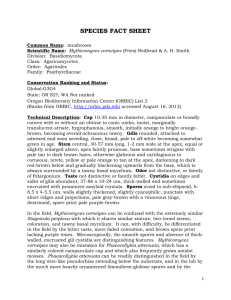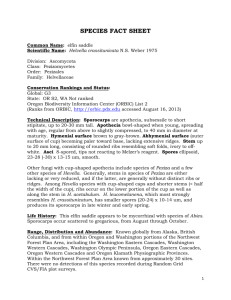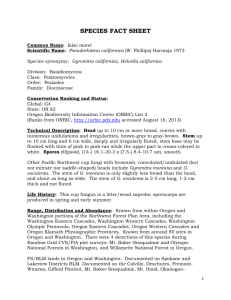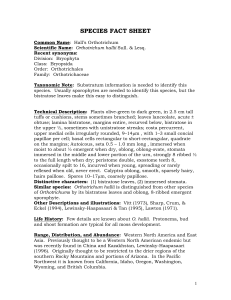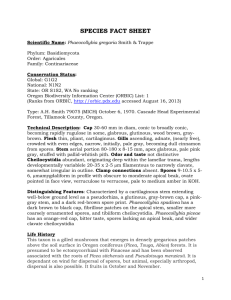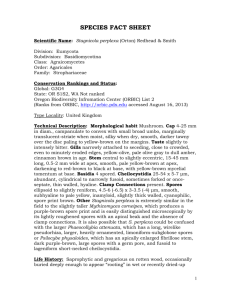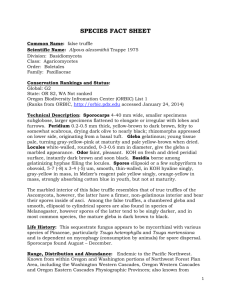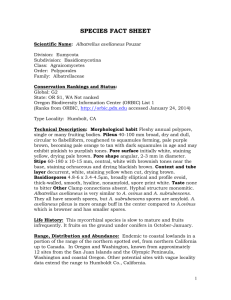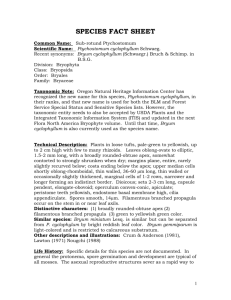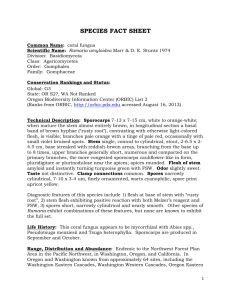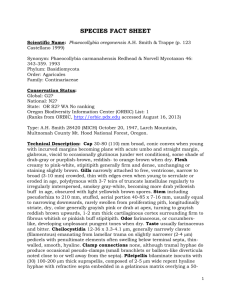Galerina atkinsoniana
advertisement
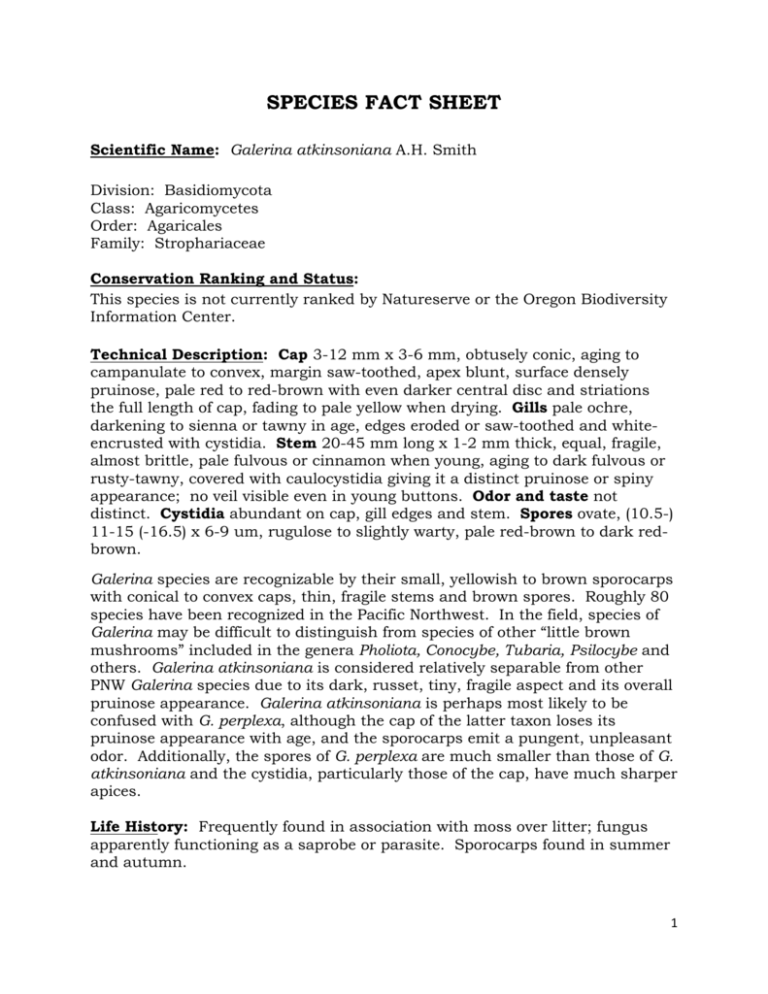
SPECIES FACT SHEET Scientific Name: Galerina atkinsoniana A.H. Smith Division: Basidiomycota Class: Agaricomycetes Order: Agaricales Family: Strophariaceae Conservation Ranking and Status: This species is not currently ranked by Natureserve or the Oregon Biodiversity Information Center. Technical Description: Cap 3-12 mm x 3-6 mm, obtusely conic, aging to campanulate to convex, margin saw-toothed, apex blunt, surface densely pruinose, pale red to red-brown with even darker central disc and striations the full length of cap, fading to pale yellow when drying. Gills pale ochre, darkening to sienna or tawny in age, edges eroded or saw-toothed and whiteencrusted with cystidia. Stem 20-45 mm long x 1-2 mm thick, equal, fragile, almost brittle, pale fulvous or cinnamon when young, aging to dark fulvous or rusty-tawny, covered with caulocystidia giving it a distinct pruinose or spiny appearance; no veil visible even in young buttons. Odor and taste not distinct. Cystidia abundant on cap, gill edges and stem. Spores ovate, (10.5-) 11-15 (-16.5) x 6-9 um, rugulose to slightly warty, pale red-brown to dark redbrown. Galerina species are recognizable by their small, yellowish to brown sporocarps with conical to convex caps, thin, fragile stems and brown spores. Roughly 80 species have been recognized in the Pacific Northwest. In the field, species of Galerina may be difficult to distinguish from species of other “little brown mushrooms” included in the genera Pholiota, Conocybe, Tubaria, Psilocybe and others. Galerina atkinsoniana is considered relatively separable from other PNW Galerina species due to its dark, russet, tiny, fragile aspect and its overall pruinose appearance. Galerina atkinsoniana is perhaps most likely to be confused with G. perplexa, although the cap of the latter taxon loses its pruinose appearance with age, and the sporocarps emit a pungent, unpleasant odor. Additionally, the spores of G. perplexa are much smaller than those of G. atkinsoniana and the cystidia, particularly those of the cap, have much sharper apices. Life History: Frequently found in association with moss over litter; fungus apparently functioning as a saprobe or parasite. Sporocarps found in summer and autumn. 1 Range, Distribution and Abundance: Within the Oregon and Washington portions of the Northwest Forest Plan Area, known from approximately 135 sites including all Oregon and Washington physiographic provinces except the Washington Western Lowlands Physiographic Province. FS/BLM lands in Oregon and Washington: Documented on Coos Bay, Eugene, Medford, Roseburg and Salem Districts BLM. Documented on the Gifford Pinchot, Mt. Baker-Snoqualmie, Mt. Hood, Okanogan-Wenatchee, Olympic, Rogue River-Siskiyou, Siuslaw, Umpqua and Willamette National Forests. Habitat Associations: Found in Western Hemlock (43%), Pacific Silver Fir (30%), Mountain Hemlock (8%), White Fir-Grand Fir (8%), Douglas Fir (5%), Sitka Spruce (3%), Subalpine Fir-Engelmann Spruce (2%) and Douglas FirTanoak (1%) vegetation zones at elevations of 325-5519 feet. Threats: It is reasonable to anticipate that threats to local occurrences of this species include events and/or activities that negatively impact either the fungal mycelium or its moss/litter substrate. Such impacts can be caused by moderate to severe fire, removal of large woody debris and litter-producing canopy layer, and soil compaction. Conservation Considerations: This is a fairly common species within the Northwest Forest Plan area. Consider revisiting known localities to confirm persistence and determine extent of populations. Consider buffering known sites from adjacent vegetation management activities. When conducting vegetation management activities in areas with good habitat potential, consider leaving scattered and clumped host trees and ample coarse woody debris, while minimizing soil compaction and burn severity of activity-related fires. Other pertinent information (includes references to Survey Protocols, etc): The survey protocol for Survey and Manage fungi is located on the Survey and Manage website: http://www.blm.gov/or/plans/surveyandmanage/protocols/ Prepared by: Rick Dewey, Deschutes NF Date: April, 2013 Edited by: Rob Huff, BLM/FS Portland, Oregon Date: January, 2014 2 ATTACHMENTS: (1) References (2) Map of Species Distribution (3) Photographs of Specie ATTACHMENT 1: References Arora, David. 1979. Mushrooms Demystified – A Comprehensive Guide to the Fleshy Fungi. Ten Speed Press, Berkeley, California. 959 pp. Castellano, M.A., E. Cazares, B. Fondrick and T. Dreisbach. 2003. Handbook to Additional Fungal Species of Special Concern in the Northwest Forest Plan. PNW-GTR-572. Ferriel, Jenifer and Katie Grenier. 2008. Annotated Bibliography of Information Potentially Pertaining to Management of Rare Fungi on the Special Status Species List for California, Oregon and Washington. R6 USFS and OR/WA BLM Interagency Special Status/Sensitive Species Program (ISSSSP). http://www.fs.fed.us/r6/sfpnw/issssp/planning-tools/ Gibson, Ian. 2008. Note on Galerina in the Pacific Northwest. Prepared for the Pacific Northwest Key Council. Gibson is a member of the South Vancouver Island Mycological Society. http://www.svims.ca/council/Galeri.htm Oregon Biodiversity Information Center. 2013. Rare, Threatened and Endangered Species of Oregon. Portland State University, Institute for Natural Resources. 111 pp. http://orbic.pdx.edu/rte-species.html 3 ATTACHMENT 2: Map of Species Distribution in OR/WA 4 ATTACHMENT 3: Photos of Galerina atkinsoniana Photo courtesy of S. Redhead Photo courtesy of mycology team Photo courtesy of P. Kroeger 5
